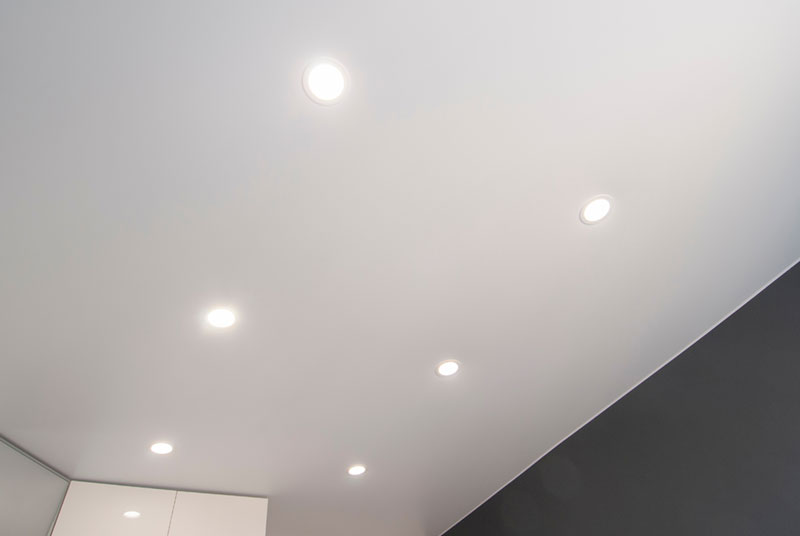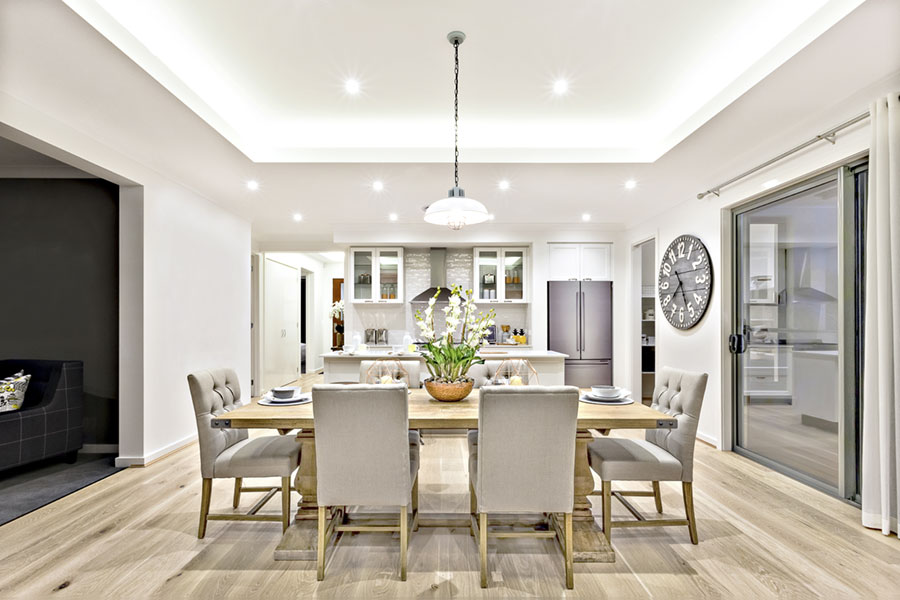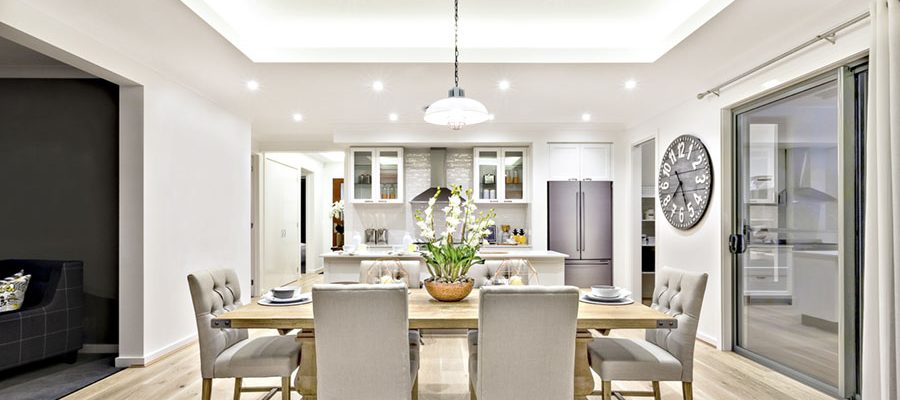You may have heard of downlights, pot lights, or can lights. But what are they? Simply put, recessed lights are light fixtures that are installed into your ceiling. They can illuminate the room without hanging down into the space like a chandelier or a pendant fixture.
There’s a lot to know about recessed lights before you install them in your home, and it can be hard to find all of that information, especially if you’re considering something other than the default 6-inch options lining the shelves of hardware stores.
So why go with 4-inch LED recessed lights? Here are some reasons:
Traditional vs LED Recessed Lights

Before LED technology came around there were only two types of recessed lights: Incandescent and compact fluorescent lamps (CFL). While both produce heat, CFLs use less energy but also contain mercury. Around 2010, LEDs started hitting the market and they’ve only gotten more popular since. Energy-efficiency is one of the main reasons; LEDs cost way less to run so you get massive savings on your energy bill. They use only a fraction of the electricity compared to traditional bulbs, and can last up to 50 times longer. Most run for years without any problems, product little heat and are mercury-free.
Light
LED technology is so efficient that even tiny bulbs can produce a very bright light (if you’ve ever tried to go to sleep in the dark with an LED indicator light on your laptop or tv, you’ll know what we mean). A standard 60W incandescent bulb can produce about 800 lumens, whereas a 9W LED bulb produces the same. Yeah…LEDs pack a powerful punch.
It’s always worth installing LED recessed lights with a dimmer switch so you can adjust the brightness levels as you see fit throughout the day.
Cost
It’s no secret that LED lights cost more upfront than traditional lights, including recessed lights. The good news is they’re worth it! LED lights need fewer watts to produce the same amount of energy, so costs are significantly less throughout the year. They also last over 10 times longer than incandescent bulbs, so you’ll only be replacing them every decade or so.
Ease of Installation
Recessed lights usually have a large housing, which means they need to be installed in between the framing lumber in your ceiling. In new builds, this isn’t a problem because the spacing of your lights can be planned out during construction.
If you decide to install recessed lights after the fact, creating an evenly spaced grid of lights becomes a lot more difficult.
Some (but not all) recessed lights can be installed in exactly the same place as your existing recessed lights. To do this, you’ll need to find a recessed light that can be “retrofitted,” meaning it has been specifically designed to work with the wiring already in place – keep in mind that some modifications may still be necessary. If you’re having trouble finding clear spaces in your ceiling and you don’t like where your current light is, don’t worry; LED technology has allowed manufacturers to slim down the housing for certain types of LED recessed lights (sometimes called “ultra-thin” or “canless” lights), creating fixtures that are only as thick as your ceiling drywall. These slimmed down lights can be installed anywhere in the ceiling, even if it’s halfway under a beam, so they’re a great choice for renovations.
4” vs 6” LED Recessed Lights
Recessed lights come in a lot of different sizes, typically from 3 – 6 inches. 6-inch recessed lights are most commonly used and have a wide variety of trim options, but their smaller 4-inch counterparts pack a pretty big punch, and may end up being a better fit for your space.
Light
Larger recessed lights can cast a wider beam of light across an area, but there’s more to it than that. The trim you choose will affect how wide or narrow the beam of light is, and how diffused the light will appear.
You also need to consider the height of your ceilings. The taller our ceilings, the more diffused the light will be across your space. When it comes to actual lumen output, both 4-inch and 6-inch LED lights are capable of producing plenty of illumination. There’s no need to buy larger (possibly overpowered) fixtures for your space when 4-inch recessed options can produce as many lumens or more.
Cost
Going with 4-inch recessed lights instead of the more popular 6-inch will cut your costs even more in a couple of ways. Because they’re smaller, they cost less than their bigger 6-inch counterparts. They also need less power to run, which translates to smaller utility bills.
4” is the New 6”
6-inch recessed lights are by far the most popular size on the shelves, although— as with every aspect of home design— popularity changes over time. For years now, home owners have been ditching ceiling lights in favor of a grid of 6-inch recessed lights, but the lack of visual interest is starting to sway designers back towards beautiful statement ceiling light fixtures like chandeliers and pendants. With these modern fixtures providing most of the ambient light for a space, larger recessed lights aren’t really necessary in the home. Smaller 4-inch lights are a much better option for creating beautiful layers of light without over-lighting your space.
4-inch lights also fit very well with modern decor styles, while 6-inch lights are most commonly found with traditional decor, giving some designers and homeowners the impression that they are outdated. Honestly speaking, they are.
Uses for 4” Recessed Lights
Multi-Purpose
While it’s possible to use 4-inch lights anywhere, they’re most commonly used in smaller spaces like the kitchen or office. They’re perfect for lighting a reading or craft area where you want to see what you’re doing. It’s a great size for highlighting artwork or architectural features without washing them out.
Create Balanced Light
4-inch recessed lights create the perfect “extra” light a room needs to feel just right. Your home rooms don’t need an equal amount of light in every square inch. Your room will actually feel much better if the lighting is tailored to the way you use it. One bright light in the center of a room will create shadows and dark corners, so you need several light sources to keep the lighting balanced.

In the dining room, compliment a pendant light over the table with recessed lights around the edges. This gives your table plenty of light, while giving the rest of the room an even glow.
Make Your Room Look Bigger
Properly placed recessed lights can make your rooms feel bigger if you employ a technique called Wall Washing. Wrapping your room in 4-inch recessed lights will evenly coat the wall with light, making things feel more spacious. This is a great trick for smaller areas like hallways and narrow rooms, and it helps to hide imperfections in the wall finish. Placement is important here; if your recessed lights are installed too closely to the wall they’ll create a cone of light (called wall grazing) which will not have the same space-creating effect.
| 4-inch | 6-inch | |
| Cost | Cheaper to purchase and to power, although you might need more of them to light an entire room | More expensive to purchase and to power |
| Uses | Lighting smaller spaces; task lighting like reading, crafting, cooking; highlighting artwork and/or architectural features; wall washing | Ambient lighting for a large room like a bedroom or living room |
| Decor | Fits well into modern decor styles | More commonly found in traditional decor |
Other Things to Consider
The size you choose matters, but there are other things you need to consider before purchasing. LED recessed lighting has come a long way in the past few years, and new features are regularly being added to the lineup.
Color
LED lights come in a wide variety of colors, measured in Kelvins (K). Warm light (up to 3000K) appears orange or yellow, like the light from traditional incandescent bulbs. It feels soft and cozy, and is a great choice for places where you want to wind down and relax, like a bedroom or a living room. Light between 3000K – 4000K is similar to midday daylight. It feels bright and white, and is a great choice for most rooms in the house. Cool light, above 4000K, starts to appear more and more blue as the Kelvins increase. Blue light feels crisp and energetic, and is often used in offices and hospitals to help keep people alert. Be careful with blue light in your home – it can play around with melatonin and make it harder to sleep well at night.
The color you choose for your lights will change how the paint on your walls looks, so it’s a good idea to experiment with it first before you commit. Some LED lights are color changing, meaning they can be set to emit warm or cool light, which takes the stress out of worrying which temperature to choose. Some, like this one, can be changed with a switch in the housing. This is great for homeowners that want to choose what they like, set it, and forget about it. Others can be changed via a remote control or a smart hub, making the lighting in your house truly customizable to any activity.
Dimmable
We recommend installing LED lights on a dimmer switch whenever possible! Because they are so bright, it’s nice to be able to dim the lights to a level you’re comfortable with throughout the day. Most LED lights are already dimmable but some aren’t, so you’ll need to double check before purchasing if this is a feature you want in your home!
Comfort Dim is one of the best dimmable technologies available in LED lighting. Traditional LEDs just become less bright as they are dimmed. Comfort Dim LEDs actually change the temperature of the light as they dim, gradually curving from a bright 2700K to a soft and comfortable 1800K. Add benefits here.
Smart Technology
Smart LED recessed lights come with the ability to communicate with other technologies in your home, like a smart hub. Depending on the features, this means you could set your lights on a schedule or even turn them on with a voice command instead of a switch.
Final Thoughts
There are a lot of things to consider when you’re installing recessed lights. Our lighting experts know all of the ins and outs and would love to share their knowledge with you to help get you started. Give us a call or stop by our showroom and see for yourself how recessed lighting can completely transform your home.
